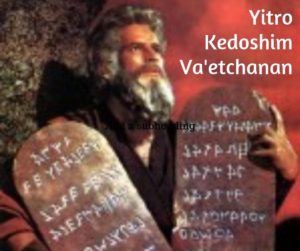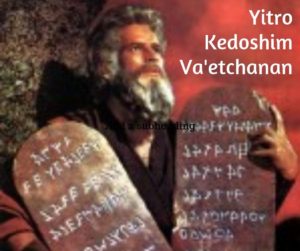
30 Jul Va’etchanan; Plurality, The 10 Commandments Repeated and Why
 Va’etchanan; Plurality, The 10 Commandments Repeated and Why
Va’etchanan; Plurality, The 10 Commandments Repeated and Why
Inspired by the teachings of Harav Yitzchak Ginsburgh and Rabbi Moshe Genuth
Regarding the receiving of the 10 Commandments, it is stated in Perkei Avot (1:1)“ Moses received the Torah from Sinai…” . What isn’t explicitly stated is ‘which Sinai’ Hashem is referring to. There is Sinai as the Desert [consciousness], and Sinai as the Mountain [consciousness]. So, which one is it?
Rav Ginsburgh brings down the teaching that ‘Sinai’ as mentioned, is both Sinai ‘the desert’ and Sinai ‘the mountain’. The desert is a totally barren place, a place that is representative of total nullification, a place just right for ‘receiving’. The mountain is representative of a place of ‘humility and uplifting’ , and the power of ‘giving’. It is necessary to have the power to both ‘receive and to be uplifting’ (in proper measure) in order to achieve things in this world.
Moses ascended Mt Sinai from below to receive the Torah from a state of ‘desert consciousness’, total nullification. He then received the Torah and related ( gave) the Torah to Joshua. Joshua having received the Torah then gave the Torah to the Elders who having received it then gave it to the Klol. In order to transmit the Torah Moshe needed to have the trait of humility (a desert consciousness) , but also an amount of uplifting, gevurah (might, strength) or ‘mountain consciousness’. We say then that it is necessary to have a drop of gevurah (might) to get anything done… to uplift.
Further, it is said that when Hashem spoke to Moshe at the Burning Bush, He called his name twice “Moshe….Moshe…”. The insight explains to us that Hashem is speaking to two levels of Moshe’s soul, the desert consciousness and the mountain consciousness.
The Plurality of the 2 times the 10 Commandments are given (of a total of 3 times)…
The first and second times the Torah gives us the 10 Commandants relates to the experiences of ;
1/ the wisdom of the mind (chochma) and
2/ the wisdom of the Heart (binah) .
This weeks parsha Va’etchanan thus brings the Shema, a prayer that is a vehicle for the culmination of these two wisdom’s (from above and below of chochma and binah) as words of action so as to be able to integrate these wisdom’s into our being as daat (knowledge)… a prayer of unification.
Plurality (defined as more than 1) of the 3 times the 10 Commandments are given…
There is yet a deeper expression of the plurality of the giving of the 10 Commandments. Where plurality may be 2 times, by definition plurality may also be 3 (or even more). In parsha Kedoshim, the Commandments take on a variation of form as they are given explanation with greater specificity. The 3 repetitions (Parshas Yitro, Parshas Kedoshim, Parshas Va’etchanan) express the Torah principle of learning as going from ‘the general- to the particular- to the general’.
In Parshas Kedoshim we have a 3rd presentation of the commandments. The commandments as they appear in Kedoshim are given with greater specificity.., i.e. more detail. We then see that although the parshas are sequential as in the chumash as the principles of general – particular – general are represented, and the associated sefirot of chochma-binah-daat (wisdom of the mind – understanding of the heart/emotive – knowledge, a culmination and elevation of chochma and binah) .
1st– Parshas Yitro as ‘general’ as chochma-wisdom of the intellect,
2nd -Parshas Kedoshim as ‘specific’, as Daat-knowledge, and
3rd -Parshas Vaetchanan as ‘general’, as Binah-understanding.
All 3 principles are represented; Chochma – Binah – Daat.
As Klol Yisroel in Va’ etchanan is on the edge of Moshe’s departure and about to enter and conquer the Land of Eretz Yisroel, We now have the power of the ‘Principles’ of the Torah teachings of going from the ‘general – to the specific – to the general’.
The resolve of plurality, also may be referred to as ‘the resolve of a paradox’,
holds within in it great power of elevation and unity…the power of Tikun.
We are constantly challenged in our own pursuits in the resolve of the plurality.
This a model for such resolve… rectification.
As the 3 repetitions in the Torah of the 10 Commandment reveal, the rectified experiences of
Chochma ( Wisdom of the Mind) and Binah (Wisdom of the Heart/Emotive),
culminate with resolve of plurality in the powerful clarity of Daat (Knowledge) .
Lawrence (Leib Getzel) Lax
Addictions and Counseling
http://lawrencelax.com
lawrenceJlax@gmail.com